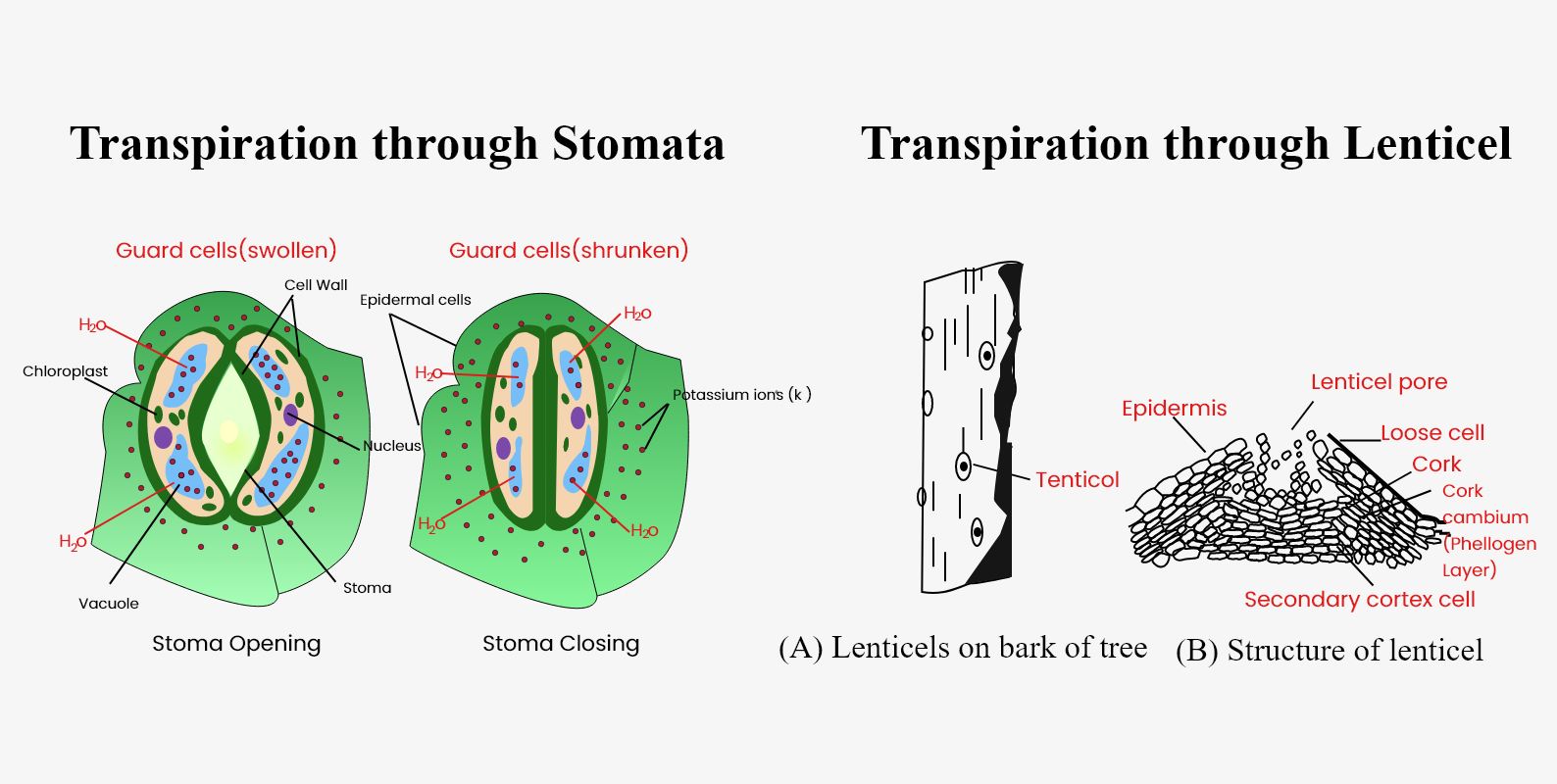
Loss of water from aerial parts of the plant is known as
(a) Photosynthesis
(b) Transpiration
(c) Reproduction
(d) Respiration
Answer
557.7k+ views
Hint: For plants, water is essential, but for growth and metabolism, only a small amount of water taken up by the roots is used. The process of water movement through the plant and its evaporation from aerial parts, such as leaves, stems, and flowers, takes place through the stomatal openings and can be seen as a necessary "cost" associated with the opening of the stomata to enable photosynthesis to disperse carbon dioxide gas from the air.
Complete answer:
The process of fluxing water from aerial elements such as leaves, twigs, and flowers through the plant is transpiration. By transpiration and guttation, the remaining 97–99.5 percent is lost. Leaf surfaces are dotted with pores called stomata, and on the undersides of the leaves, they are more abundant in most plants. Guard cells and their stomatal accessory cells (together known as stomatal complex) that open and close the pore are bordered by the stomata. The stomatal apertures contain transpiration.
Additional Information: The transpiration also cools the plants, changes the osmotic pressure of the cells, and shifts the mass from the roots to the mineral nutrients and the water. The water flow rate from the soil to the roots is determined by two major factors: the hydraulic conductivity of the soil and the magnitude of the pressure gradient through the soil. The rate of bulk flow of water moving from the roots to the stomatal pores in the leaves through the xylem affects each of these factors. By regulating the size of the stomatal apertures, plants regulate the rate of transpiration. The amount of transpiration also affects the ambient evaporative demand of the leaf, such as boundary layer conductivity, humidity, temperature, wind and incident sunlight, soil temperature, and humidity may affect the opening of the stomatal.
So, the answer is, “Transpiration.”
Note: - Photosynthesis is the mechanism of food synthesis from inorganic compounds such as carbon dioxide, sunlight, and water.
- The method of producing offspring for the continuation of the species is reproduction.
- By breaking down organic compounds like sugars, respiration is the process of releasing energy.
- Guttation is the exudation of drops of xylem sap and a variety of fungi on the tips or edges of leaves of certain vascular plants, such as grasses. Guttation is not to be confused with dew that condenses onto the surface of the plant from the atmosphere. Guttation normally occurs in the night time.

Complete answer:
The process of fluxing water from aerial elements such as leaves, twigs, and flowers through the plant is transpiration. By transpiration and guttation, the remaining 97–99.5 percent is lost. Leaf surfaces are dotted with pores called stomata, and on the undersides of the leaves, they are more abundant in most plants. Guard cells and their stomatal accessory cells (together known as stomatal complex) that open and close the pore are bordered by the stomata. The stomatal apertures contain transpiration.
Additional Information: The transpiration also cools the plants, changes the osmotic pressure of the cells, and shifts the mass from the roots to the mineral nutrients and the water. The water flow rate from the soil to the roots is determined by two major factors: the hydraulic conductivity of the soil and the magnitude of the pressure gradient through the soil. The rate of bulk flow of water moving from the roots to the stomatal pores in the leaves through the xylem affects each of these factors. By regulating the size of the stomatal apertures, plants regulate the rate of transpiration. The amount of transpiration also affects the ambient evaporative demand of the leaf, such as boundary layer conductivity, humidity, temperature, wind and incident sunlight, soil temperature, and humidity may affect the opening of the stomatal.
So, the answer is, “Transpiration.”
Note: - Photosynthesis is the mechanism of food synthesis from inorganic compounds such as carbon dioxide, sunlight, and water.
- The method of producing offspring for the continuation of the species is reproduction.
- By breaking down organic compounds like sugars, respiration is the process of releasing energy.
- Guttation is the exudation of drops of xylem sap and a variety of fungi on the tips or edges of leaves of certain vascular plants, such as grasses. Guttation is not to be confused with dew that condenses onto the surface of the plant from the atmosphere. Guttation normally occurs in the night time.

Recently Updated Pages
Master Class 12 Business Studies: Engaging Questions & Answers for Success

Master Class 12 Economics: Engaging Questions & Answers for Success

Master Class 12 English: Engaging Questions & Answers for Success

Master Class 12 Maths: Engaging Questions & Answers for Success

Master Class 12 Social Science: Engaging Questions & Answers for Success

Master Class 12 Chemistry: Engaging Questions & Answers for Success

Trending doubts
What is meant by exothermic and endothermic reactions class 11 chemistry CBSE

Which animal has three hearts class 11 biology CBSE

10 examples of friction in our daily life

One Metric ton is equal to kg A 10000 B 1000 C 100 class 11 physics CBSE

1 Quintal is equal to a 110 kg b 10 kg c 100kg d 1000 class 11 physics CBSE

Difference Between Prokaryotic Cells and Eukaryotic Cells




